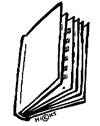|
|
|
 |
WITHIN THE PAPER PARENTHETICAL DOCUMENTATION
|
MLA format or style refers to guidelines given in The MLA Handbook for Writers of Research Papers (5th edition). It is the format most commonly used by colleges and high schools. Copies of this book are available in the HHS library and in most bookstores. Each English teacher also has a copy.MLA format follows the author-page method of citation or documentation. This means that the author's last name and the page number(s) from which the quotation is taken must appear in the text, and a complete reference should appear in your works-cited list, which appears at the end of the paper.
The author's name may appear either in the sentence itself or in parentheses following the quotation, but the page number(s) should always appear in the parentheses, not in the text of your sentence.
Citing information used in a research paper is very important; not giving credit to sources used is plagiarism. A very useful discussion of plagiarism, how to avoid it, and when to credit sources is found on the website of the Purdue University Online Writing Lab.
Click on the areas below for more information.
When to cite / document
|
|
|
| When you are using or referring
to somebody
else's words or ideas from a magazine, book, newspaper, song, TV program, movie, Web page, computer program, letter, advertisement, or any other medium When you use information gained
through
When you copy the exact words
or a "unique
When you give statistics When you reprint any diagrams,
illustrations,
When you use ideas that others
have given you
|
When you are writing your
own experiences, your
own observations, your own insights, your own thoughts, your own conclusions about a subject When you are using "common
knowledge" —
When you are compiling generally accepted facts
|
Back
to top
SHORT QUOTATIONS--GUIDELINES Back to top
To indicate short quotations (fewer than four typed lines of prose or three lines of verse) in your text, enclose the quotation within double quotation marks and incorporate it into your text.
Provide the author and specific page citation ( in the case of verse, provide line numbers) in the text, and include a complete reference in the works-cited list.
Punctuation marks such as periods, commas, and semicolons should appear within the quotation marks if they are a part of the quoted passage but after the parenthetical citation if they are a part of your text.
Click here to see examples.
LONG QUOTATIONS--GUIDELINES Back to top
Place quotations longer than four typed lines in a free-standing block of typewritten lines, and omit quotation marks.
Start the quotation on a new line, indented one inch from the left margin, and maintain double-spacing.
Your parenthetical documentation should come AFTER the closing punctuation mark. When quoting verse, maintain original line breaks.
Click here to see examples.
For a source that has been paraphrased:
Ancient writers attributed the invention
of the monochord to Pythagoras, who lived in the sixth century BC (Marcuse
197).
For a quote in which the author's name is given in the sentence:
Freud states that "a dream is the
fulfillment of a wish" (154).
For an indirect quotation:
Milroy described himself as "a non-political
politician" (qtd. in Newley, 18).
For a long quotation in prose: Back to top
Ralph and the other boys finally realize the horror of their actions:
The tears began to flow and sobs shook him. He gave himself to them for the first time
on the island; great shuddering spasms of grief that seemed to wrench his whole body.
His voice rose under the black smoke before the burning wreckage of the island; and
infected by that emotion, the other boys began to shake and sob too.
(Golding 186)
For a long quotation in verse:
Elizabeth Bishop's "In the Waiting Room" is rich in evocative detail:
It was winter. It got dark
early. The waiting room
was full of grown-up people,
arctics and overcoats,
lamps and magazines. (6-10)
Hallsville ISD
Martha J. Dalby 1 August 2001